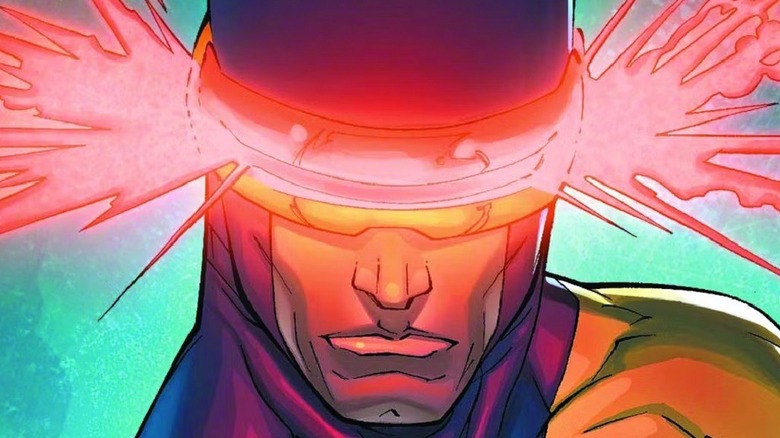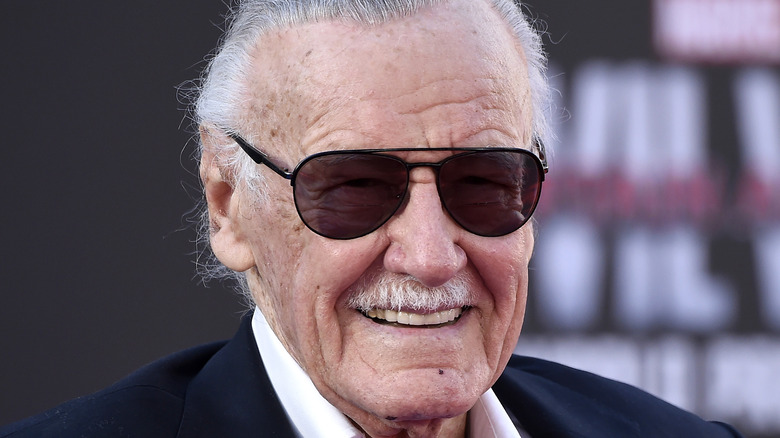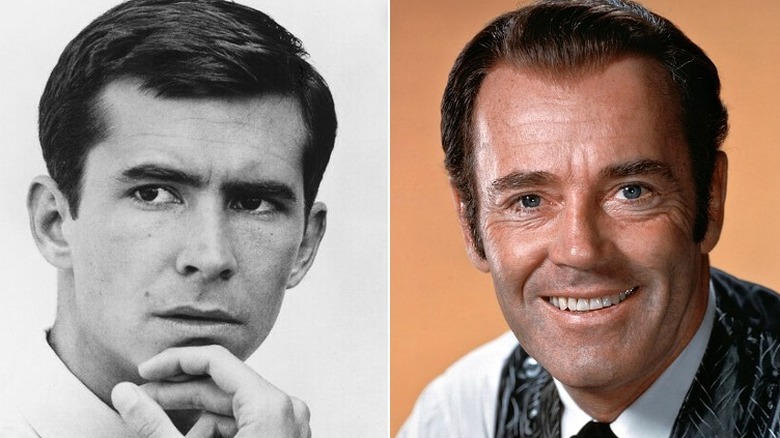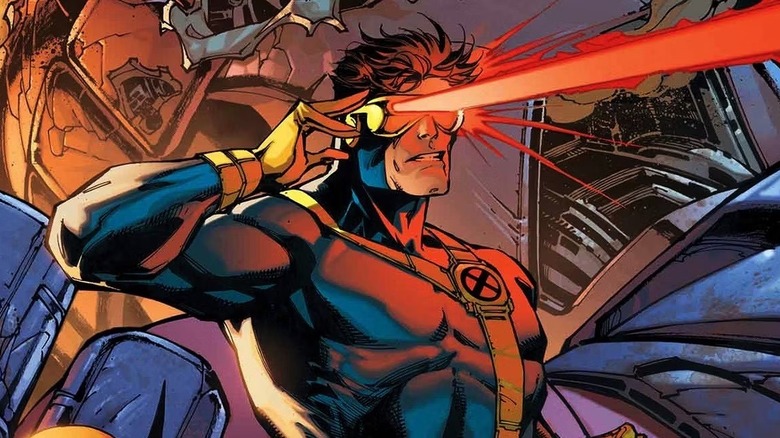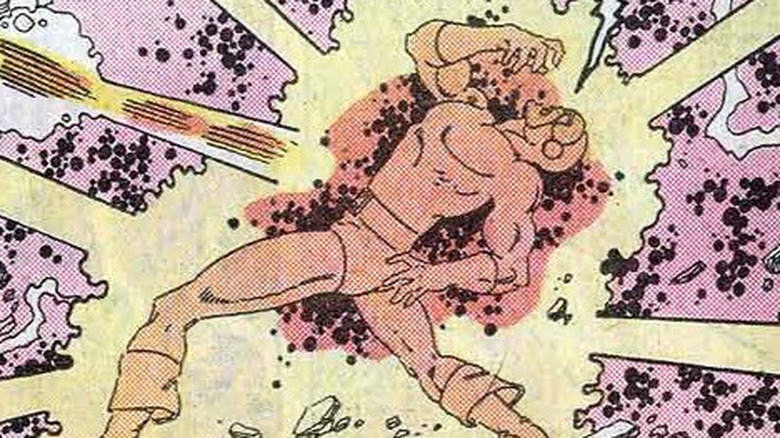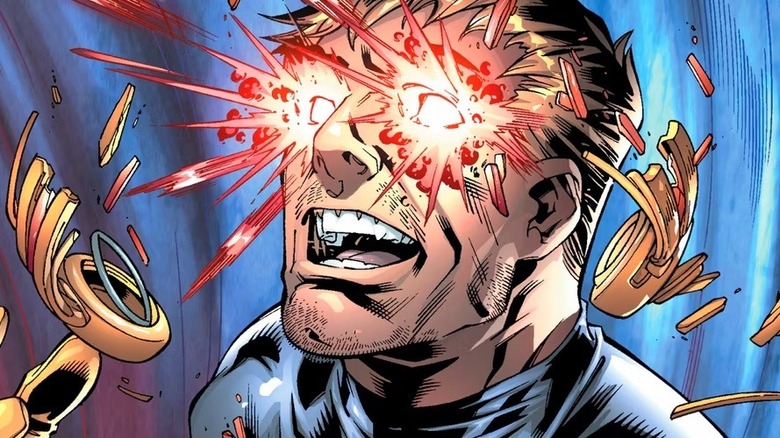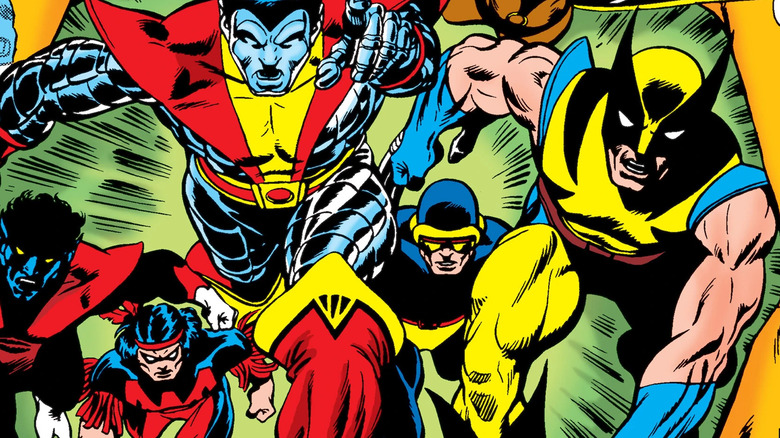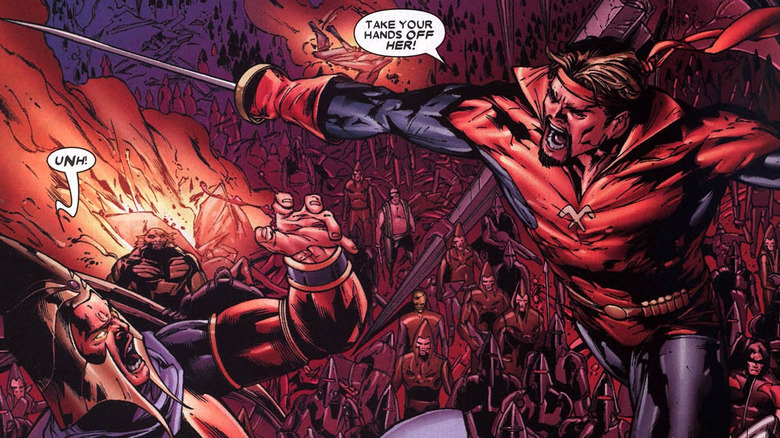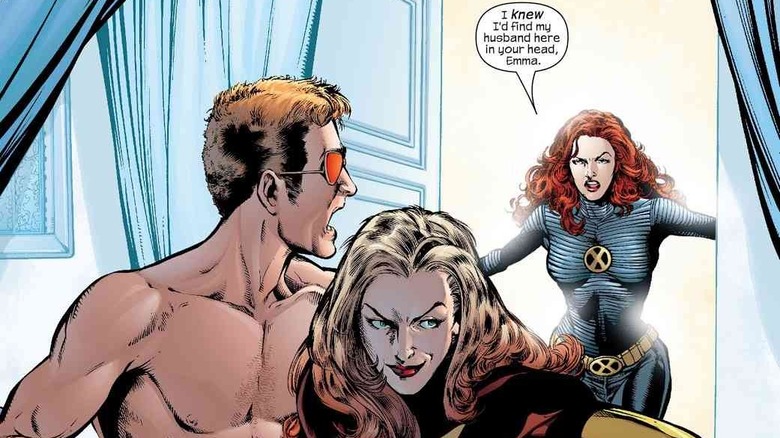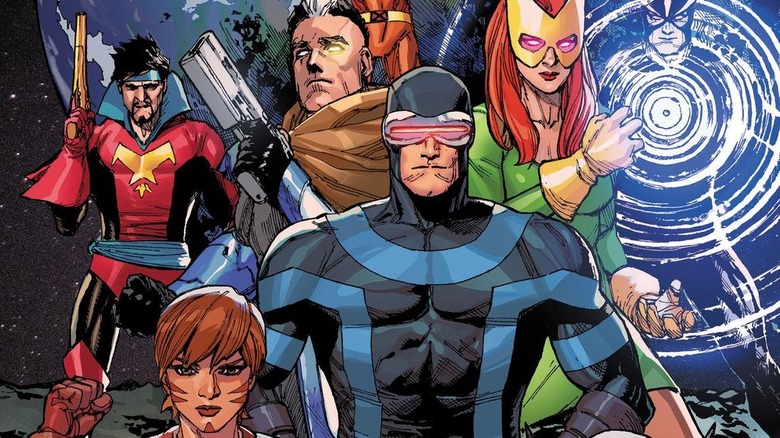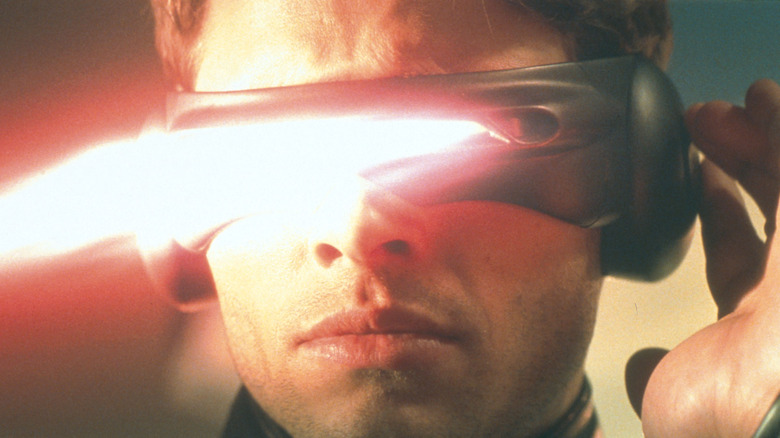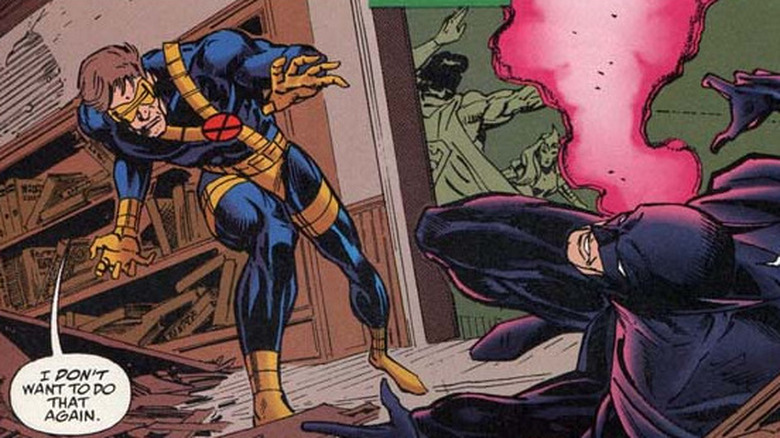The Untold Truth Of Marvel's Cyclops
While he may not be the most popular member of his team, there is no denying that Scott Summers, aka Cyclops, is the quintessential X-Man. As the handpicked leader of Professor Charles Xavier's superhero team, the spandex-clad, scarlet-spectacled sharpshooter has served as the X-Men's commander for nearly his entire adult life. Combined with his mastery of trigonometry and spatial awareness, Cyclops' optic blasts make him a true force to be reckoned with — and his brilliant tactical mind makes him an undeniable asset on any battlefield.
Unfortunately, being the leader means that he often has to make difficult decisions and keep everyone else in line. This has given many superhero fans — especially those who are unfamiliar with the character's layers of complexity, no doubt thanks to the way he has been portrayed in numerous adaptations of the source material — the terribly inaccurate misconception that he's nothing but a boring stick in the mud who is completely devoid of a personality.
In reality, the man who is literally forced to look at life through rose-colored glasses has lived quite a colorful life. Despite all the pain and suffering he has seen and endured, he continues to soldier on, fighting for a dream that many have deemed too naïve and idealistic. This is the untold truth of Marvel's Cyclops — a laser-focused leader, a passionate freedom fighter, and a tortured, complicated hero.
Stan Lee's favorite X-Man
As one of the early superheroes of the modern Marvel universe, Cyclops was co-created by writer Stan Lee and artist Jack Kirby. Cyclops made his comics debut alongside his mutant teammates in 1963's "X-Men" Vol. 1 #1. Years after the superhero team achieved massive popularity and penetrated the mainstream consciousness, Lee talked about what inspired their creation — and who his favorite X-Men were.
In an interview for the 2006 book "Comics Creators on X-Men," the mighty Marvel mastermind shared that he decided to make the X-Men mutants simply because he didn't want to have to come up with a more complicated explanation behind how they got their powers. Citing the various ways mutations manifest in the real world (such as extra appendages in amphibians), the writer decided that establishing the X-Men as being "born that way" was an appropriate (albeit "cowardly," in his own words) solution. "I can get these guys to have any power I want," said Lee (via UncannyXMen.net). "Nobody can argue with that!"
Meanwhile, in a special "X-Men Turn Thirty" issue of Wizard Magazine, Lee revealed that among the X-Men, the characters he was drawn to the most were Cyclops and the Beast. According to Lee, Cyclops was a favorite of his because of his conflicted nature, being blessed — or perhaps cursed — with his optic blasts. "I love tortured heroes and he was tortured because he couldn't control his power. He was the serious, brooding one
The Hollywood actors that inspired Cyclops' voice
It's not hard to argue that if the entire X-Men franchise had a single primary protagonist who captures the essence of the series, it's Cyclops. His character traits, his role as team leader, and his iconic design easily make him the de facto representative of Marvel mutantkind. But have you ever thought about who Cyclops' writers thought he should sound like?
If you grew up in the '90s watching "X-Men: The Animated Series" or playing the various Capcom games that featured the X-Men, you probably hear the voice of the late Norm Spencer whenever you read Cyclops' dialogue in the comics. However, back when the now-iconic stories featuring the character were still being written by the legendary X-Men scribes of yesteryear, there were at least two Hollywood stars who reportedly served as the inspiration behind the mutant leader's "voice."
Per the recollection of (and typewritten evidence presented by) former Marvel Comics assistant editor Scott Edelman, Stan Lee felt that Cyclops should sound like Anthony Perkins, best known as the actor who played Norman Bates in Alfred Hitchcock's "Psycho." Years later, when Chris Claremont took the reins of the "X-Men" book, he supposedly wrote Cyclops to sound like a young version of Henry Fonda, known for films like 1940's "The Grapes of Wrath" and 1957's "12 Angry Men."
What are Cyclops' eye beams, exactly?
Because of the way they're drawn in the comics — and because of the similarity between Cyclops' primary mutant ability and one of Superman's most iconic superpowers — it's understandable that some would assume that the red beams coming out of Scott Summers' eyes are heat rays. In fact, a few comic panels and live-action scenes over the decades have shown Cyclops' eye beams catching fire or melting things. Those are inaccurate portrayals of his power, though, as his eye blasts are actually beams of concussive force from an alternate dimension full of particles that "generate great, directional concussive force when they interact with the objects of this universe" (per 1983's "Official Handbook of the Marvel Universe" Vol. 1 #3).
While Scott's powers have been explained in slightly different ways across the decades, the most consistent explanation for his mutant abilities by far is this: His eyeballs are not the typical organic structures that human beings use for seeing, but are actually interdimensional gateways that enable energy from the aforementioned alternate dimension to reach ours. As explained by 2004's "Official Handbook of the Marvel Universe: X-Men," Cyclops' body absorbs and stores sunlight and other forms of ambient energy, while a psionic field emitted by his brain make his cells impossible to penetrate by the interdimensional force. This is how he is able to hold back his optic blasts by keeping his eyes closed (despite being unable to control them when his eyes are open).
He can absorb lightning in a pinch
Numerous official explanations of Cyclops' mutant abilities over the years mention the role of ambient energy absorption — specifically, solar energy — in enabling the X-Men's fearless leader to use his eyes as portals and unleash optic beams upon his enemies. But what happens when solar power simply isn't an option? As it turns out, a 1979 comic book answered that question by showing Cyclops absorbing energy from an unexpected source.
In "X-Men Annual" Vol. 1 #3, the X-Men search for Storm on Polemachus, a planet said to be occupying the same position as Earth on a different dimensional plane. After the obligatory "heroes-get-into-a-big-fight-due-to-a-massive-misunderstanding" encounter, the Polemachian named Arkon the Magnificent explains the predicament of his people to the X-Men. Instead of a sun, their planet has a device that generates an energy ring around it, which has begun to malfunction (posing a threat to their survival). Since Thor was able to help them out last time, Arkon hoped that Storm could use her powers in a similar manner.
The X-Men come up with a creative (albeit inelegant) solution: They fix the machine and use Cyclops' optic beams, which he harnesses by absorbing Storm's lightning, to charge it. As the issue's narration box puts it: "Cyclops' system is genetically geared to absorb solar energy — not lightning. It's like a high-performance engine primed for high-octane premium gas suddenly forced to run on low-octane regular."
Why can't Cyclops control his eyebeams?
Save for a handful of moments in the comics, Cyclops has always lacked the ability to control his optic beams (aside from keeping his eyes closed to hold them back). In order for Scott to even be able to function with his eyes open, he needs to wear glasses with ruby quartz lenses — or, in combat situations, his signature ruby quartz visor. As it turns out, this handicap is directly tied to one of his greatest personal tragedies: A combination of physical injury and psychological trauma resulting from the same horrific event that separated him from his family.
As recounted in comics like 1995's "X-Factor" Vol. 1 #115, Scott and his brother Alex (who would grow up to be the mutant superhero Havok) nearly died when a plane carrying them and their parents, Chris and Katherine, was blasted by an alien ship. Thanks to a last-minute save by their mother, Scott and Alex were thrown out of the burning plane with the only working parachute. However, Scott's brain sustained a serious injury, concentrated specifically in the area that could have allowed him to control his eye beams.
Scott was sent to an orphanage due to the machinations of eventual X-Men villain Mr. Sinister, where he stayed until he was a teenager. He started experiencing increasingly severe headaches due to his burgeoning powers, and was given ruby quartz glasses to keep them in check. Eventually, he ran away and ended up at Xavier's.
The bridge between generations of X-Men
Given how the X-Men have become so deeply ingrained in popular culture, it's admittedly hard to imagine that there was ever a time when they were on the verge of extinction. Beginning in 1970's "X-Men" Vol. 1 #67 all the way up to 1975's "X-Men" Vol. 1 #93, the series merely reprinted old X-Men stories instead of publishing new ones. It took a bold effort on Marvel's part to revitalize the super-team — and fortunately, it worked. With Cyclops still at the helm, no less.
Published in 1975, "Giant-Size X-Men" Vol. 1 #1 served as a transition issue between the old and new X-Men teams. When the original squad (consisting of Cyclops, Jean Grey, Beast, Angel, and Iceman, plus Havok and Polaris) gets captured by the living island Krakoa, Charles Xavier assembles a new group of mutants from all over the world to act as a search and rescue squad. This fresh roster featured the impervious Russian Colossus, the fiery Japanese warrior Sunfire, the African weather manipulator Storm, the German teleporter Nightcrawler, the sonic-screaming Irishman Banshee, the Native American powerhouse Thunderbird, and a hot-tempered, clawed Canadian named Wolverine.
Under the leadership of Cyclops (whom Krakoa allowed to escape as a ploy to capture more mutants), they were able to rescue the old team. Soon after, the old-timers left the squad (though as we now know, that didn't last for long), while Cyclops stayed behind to lead and train the new recruits.
A father and a brother retconned into Cyclops' life
Over the years, attempts to flesh out Cyclops' backstory have resulted in previously unknown Summers family members being introduced and retroactively added to the optic-blasting mutant's character history. During his run on "X-Men," artist Dave Cockrum introduced a band of intergalactic pirates called the Starjammers. According to the Westfield Comics Blog, Cockrum had actually intended the team to headline their own Marvel book. Unfortunately, neither "Marvel Spotlight" nor "Marvel Premiere" (the company's books created for the purpose of introducing new characters) could fit the team into their already-packed publishing schedules for the next two years.
Undaunted, Cockrum shared his concept with "X-Men" writer Chris Claremont, who liked the Starjammers enough to debut them in 1977's "X-Men" Vol. 1 #104. In subsequent issues, Corsair is revealed to be Cyclops' long-lost father Christopher, a decision made so that the team could be recurring guest stars in the book.
The existence of a third Summers brother was a mystery that was dangled for quite some time in the X-books. It was resolved in 2006's "X-Men: Deadly Genesis" Vol. 1 #1 with the introduction of Vulcan (Gabriel Summers). The issue retcons the events of "Giant-Size X-Men" Vol. 1 #1 by revealing that Charles Xavier actually sent another secret team to Krakoa before the "Giant-Size" squad. This roster failed to rescue the OG team, and seemingly perished on Krakoa. Vulcan survived, though, and became a sometimes-friend, sometimes-foe to the X-Men.
A thing for telepaths?
Despite his aloofness and tendency to self-isolate, there has been no shortage of romantic encounters in the life of Scott Summers — and many of his prominent relationships, interestingly enough, have been with mutant telepaths.
As one of the first students at Xavier's and a founding member of the X-Men, Jean Grey has known Cyclops for a long time. Her relationship with Scott had plenty of time and room to blossom over the years (despite her death and eventual resurrection as the Phoenix), culminating in their marriage in the pages of 1994's "X-Men" Vol. 2 #30. Unfortunately, after going MIA for some time while being possessed by the ancient mutant Apocalypse, Scott's life took a dark turn and a rift began to form between him and his wife.
The reformed villain Emma Frost, another powerful telepath, stepped in, holding psychic therapy sessions with Scott that quickly became a telepathic affair. Jean discovered their relationship, prompting Scott to leave the team for some introspection. Before he and his wife could properly reconcile, though, Jean was murdered by Magneto, who had disguised himself as a new X-Men recruit to infiltrate the team. Years later, Jean came back to life once more and was reunited with Scott on the newly established mutant nation of Krakoa.
Cyclops was also briefly married to Madelyne Pryor (a clone of Jean with similar powers) after Jean's first death. Additionally, he engaged in a flirtatious fling — one that ultimately went nowhere — with his telepathic teammate Psylocke.
The many children of Scott Summers
If you think Cyclops' family history is complicated, the subject of his progeny is equally convoluted. Canonically, he has at least three children: Two from alternate realities, and one raised in the far future of the main Marvel Earth (Earth-616).
Instantly recognizable thanks to his scarred eye, his cybernetic arm, and his affinity for gigantic guns, the mutant known as Cable is Nathan Summers, the son of Scott and Madelyne Pryor. Infected with a techno-organic virus as an infant, Cable was sent 2,000 years into the future by Cyclops as a last-ditch attempt to save his life. He was left in the care of a powerful telepath called Mother Askani (later revealed to be an alternate version of his half-sister Rachel from another Earth), but managed to return to the current era as an adult and fight alongside the X-Men.
Meanwhile, Rachel Summers is the daughter of Scott and Jean on Earth-811, an alternate future where mutants have been nearly exterminated by the government's Sentinel program. Due to a complicated series of events stemming from her efforts to change the past and prevent her horrible future from taking place, Rachel found herself in the present day of mainstream continuity. Like her half-brother Cable, she joins the X-Men with her father and mother.
Lastly, X-Man (Nathaniel Grey) is an Omega-level mutant engineered from Scott's and Jean's genetic material who has acted as both an ally and an enemy of the X-Men.
From comic team leader to half-baked movie character
It's often said that the "X-Men" films from 20th Century Fox, especially the first trilogy, played a massive role in the development of the superhero film genre. With 13 films across two decades — from 2000's "X-Men" to 2020's "New Mutants" — the mutant-centric cinematic franchise was able to highlight the colorful adventures, bizarre powers, and high-stakes drama of this particular corner of the Marvel universe. Unfortunately, for all that it got right, one aspect of the X-Men's history it certainly could have done a better job with was the way it represented Cyclops.
In the 2000-2006 "X-Men" trilogy, James Marsden portrayed the visor-wearing superhero. However, most of the spotlight was given to his more popular teammate Wolverine (Hugh Jackman), while Cyclops' role seemed to diminish with each film. He was even given an unceremonious, off-screen death in 2006's "X-Men: The Last Stand," though that was partly due to Marsden's hectic schedule after committing to appear in a different superhero film, "Superman Returns."
Fans of Cyclops were given a small treat in 2014's "X-Men: Days of Future Past." Marsden showed up alive and well at the end, after the events of the film led to their reality being rewritten (and his death undone). Years later, Tye Sheridan portrayed a different version of the character in 2016's "X-Men: Apocalypse" and 2019's "X-Men: Dark Phoenix," both of which went down terribly with the critics — "Apocalypse" holds a score of 46% on Rotten Tomatoes, while "Dark Phoenix" only managed 22%.
He nearly beat Batman in a one-on-one match
In 1996's "DC/Marvel: All Access" Vol. 1 #4, characters from Marvel and DC encounter each other, as the barrier between their universes starts to collapse. This monumental crossover event leads to the creation of the Amalgam universe, a temporary merger of the two comic book universes and their respective heroes and villains.
Before the Amalgam universe's genesis, however, a brief battle breaks out between the X-Men (Cyclops, Jean Grey, Iceman, Storm, Jubilee, Bishop, and Cannonball) and the Justice League (Superman, Batman, Wonder Woman, the Flash, Aquaman, Green Lantern, and Martian Manhunter). Batman and Cyclops square off, with the Dark Knight briefly gaining an edge over Cyclops. The optic-blasting mutant turns the tables on the Caped Crusader and successfully incapacitates Batman with a well-placed beam to his leg. "I don't want to do that again," says Cyclops, asking Batman to stop the League from continuing the battle.
While this technically isn't a conclusive "victory," it does show that when Scott Summers is determined and fully focused, he can bring down even the most dangerous, strategic, and intimidating opponent. If getting one over on Batman doesn't earn him the respect he deserves, we're not sure what will.
